Instruction
You CAN Handle the Truth: The Importance of Measurable Data in the Golf Swing
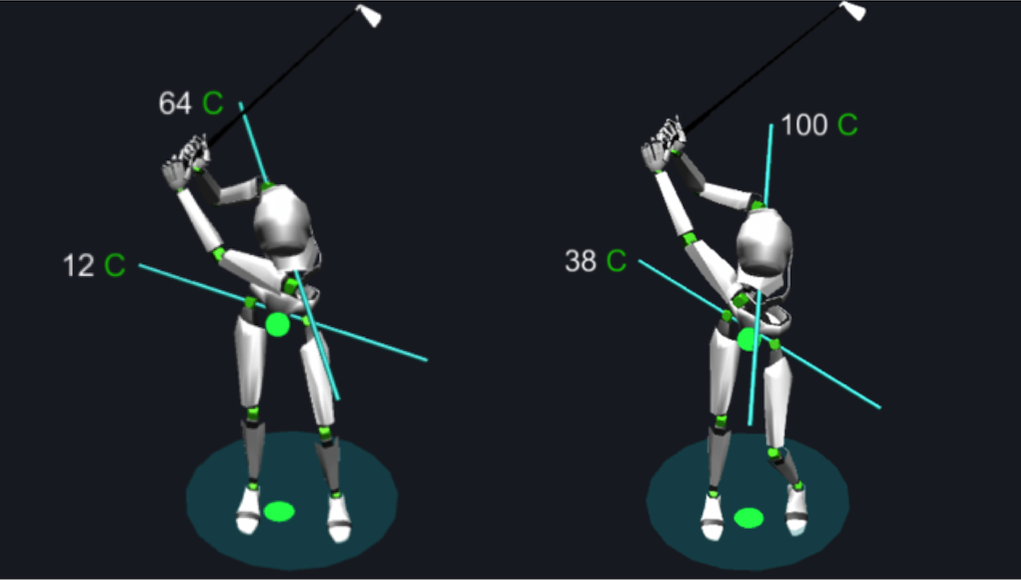
There are a lot of things we can argue about: pitcher or designated hitter, Superman or Batman, Ginger or Mary Ann, Coke or Pepsi. There are equally heated debates in the golf instruction world, and those arguments often go in circles without reaching a conclusion.
In golf, technology can help settle arguments by providing us with what I like to call “measurable truth.” If I can measure something in the swing, I can show you the truth and show you what needs to change. I’m not talking about video, though. Video doesn’t give us “measurable truth.” It gives us visual evidence of something that might be happening. To achieve a measurable truth, you need to capture a golfer’s movement in three dimensions. That’s where MySwing Professional comes in.
MySwing Professional is a full-body 3D system that uses wireless sensors to measure how and how much a golfer moves during a swing (or in the case of this article, how much a golfer doesn’t move). And that’s what we coaches deal with: movement, incorrect movement or lack of movement.
Recently, I had a player come to me searching for lost distance and swing speed. He has a fantastic swing, but in our pre-lesson interview he told me he’s now a club-and-a-half shorter through the bag, hitting hybrids into most par 4’s. It was clear I had to show the “measurables” for him to know the truth.
He hit some shots with a 6 iron; we captured his swing on video and in 3D using MySwing Pro. What we saw on video looked pretty good, but the 3D data from MySwing Pro showed us something completely different. He didn’t have enough hip turn and body turn. It was measured data that gave us the real story about what was happening. It showed he was only making a three-quarter swing at best with limited hip turn and shoulder turn.
The Old, Short Swing
The Fix: I had to get him moving better so we could add more “punch” to his swing. The simple advice I gave him was when the hips want to stop, keep them going until the left foot rolls and the heel lifts off the ground.
We worked on that without a golf ball at first, just taking some swings casually with this improved turn and freed-up footwork. After a few reps with the new motion, I had him flip the club around so he was gripping the club head and swinging the grip. I wanted him to turn it loose and hear the loud “whoosh” of the club. Once he had these two moves down we returned to the hitting station and put the club on the ball. With the bigger turn and better move to the right he quickly regained his lost distance.
The New, Longer Swing
What I’ve found is the player learns faster when a “measurable truth” is revealed. And sometimes, that’s all the player needs: to buy in and improve at a much faster rate. For this player, improved backswing size equals no more hybrids into par 4’s, which gave him more birdie putts and allowed him to have more fun on the course. And that’s what it’s all about.
P.S. The correct answers to the start of the article are: Pitcher, Superman, Ginger and Coke.
- LIKE140
- LEGIT8
- WOW0
- LOL1
- IDHT0
- FLOP3
- OB1
- SHANK3
Instruction
The Wedge Guy: The easiest-to-learn golf basic

My golf learning began with this simple fact – if you don’t have a fundamentally sound hold on the golf club, it is practically impossible for your body to execute a fundamentally sound golf swing. I’m still a big believer that the golf swing is much easier to execute if you begin with the proper hold on the club.
As you might imagine, I come into contact with hundreds of golfers of all skill levels. And it is very rare to see a good player with a bad hold on the golf club. There are some exceptions, for sure, but they are very few and very far between, and they typically have beat so many balls with their poor grip that they’ve found a way to work around it.
The reality of biophysics is that the body moves only in certain ways – and the particulars of the way you hold the golf club can totally prevent a sound swing motion that allows the club to release properly through the impact zone. The wonderful thing is that anyone can learn how to put a fundamentally sound hold on the golf club, and you can practice it anywhere your hands are not otherwise engaged, like watching TV or just sitting and relaxing.
Whether you prefer an overlap, interlock or full-finger (not baseball!) grip on the club, the same fundamentals apply. Here are the major grip faults I see most often, in the order of the frequency:
Mis-aligned hands
By this I mean that the palms of the two hands are not parallel to each other. Too many golfers have a weak left hand and strong right, or vice versa. The easiest way to learn how to hold the club with your palms aligned properly is to grip a plain wooden ruler or yardstick. It forces the hands to align properly and shows you how that feels. If you grip and re-grip a yardstick several times, then grip a club, you’ll see that the learning curve is almost immediate.
The position of the grip in the upper/left hand
I also observe many golfers who have the butt of the grip too far into the heel pad of the upper hand (the left hand for right-handed players). It’s amazing how much easier it is to release the club through the ball if even 1/4-1/2″ of the butt is beyond the left heel pad. Try this yourself to see what I mean. Swing the club freely with just your left hand and notice the difference in its release from when you hold it at the end of the grip, versus gripping down even a half inch.
To help you really understand how this works, go to the range and hit shots with your five-iron gripped down a full inch to make the club the same length as your seven-iron. You will probably see an amazing shot shape difference, and likely not see as much distance loss as you would expect.
Too much lower (right) hand on the club
It seems like almost all golfers of 8-10 handicap or higher have the club too far into the palm of the lower hand, because that feels “good” if you are trying to control the path of the clubhead to the ball. But the golf swing is not an effort to hit at the ball – it is a swing of the club. The proper hold on the club has the grip underneath the pad at the base of the fingers. This will likely feel “weak” to you — like you cannot control the club like that. EXACTLY. You should not be trying to control the club with your lower/master hand.
Gripping too tightly
Nearly all golfers hold the club too tightly, which tenses up the forearms and prevents a proper release of the club through impact. In order for the club to move back and through properly, you must feel that the club is controlled by the last three fingers of the upper hand, and the middle two fingers of the lower hand. If you engage your thumbs and forefingers in “holding” the club, the result will almost always be a grip that is too tight. Try this for yourself. Hold the club in your upper hand only, and squeeze firmly with just the last three fingers, with the forefinger and thumb off the club entirely. You have good control, but your forearms are not tense. Then begin to squeeze down with your thumb and forefinger and observe the tensing of the entire forearm. This is the way we are made, so the key to preventing tenseness in the arms is to hold the club very lightly with the “pinchers” — the thumbs and forefingers.
So, those are what I believe are the four fundamentals of a good grip. Anyone can learn them in their home or office very quickly. There is no easier way to improve your ball striking consistency and add distance than giving more attention to the way you hold the golf club.
More from the Wedge Guy
- The Wedge Guy: Golf mastery begins with your wedge game
- The Wedge Guy: Why golf is 20 times harder than brain surgery
- The Wedge Guy: Musings on the golf ball rollback
- LIKE86
- LEGIT13
- WOW6
- LOL1
- IDHT0
- FLOP4
- OB1
- SHANK8
Instruction
Clement: Stop ripping off your swing with this drill!

Not the dreaded headcover under the armpit drill! As if your body is defective and can’t function by itself! Have you seen how incredible the human machine is with all the incredible feats of agility all kinds of athletes are accomplishing? You think your body is so defective (the good Lord is laughing his head off at you) that it needs a headcover tucked under the armpit so you can swing like T-Rex?
- LIKE0
- LEGIT2
- WOW2
- LOL0
- IDHT0
- FLOP0
- OB0
- SHANK2
Instruction
How a towel can fix your golf swing
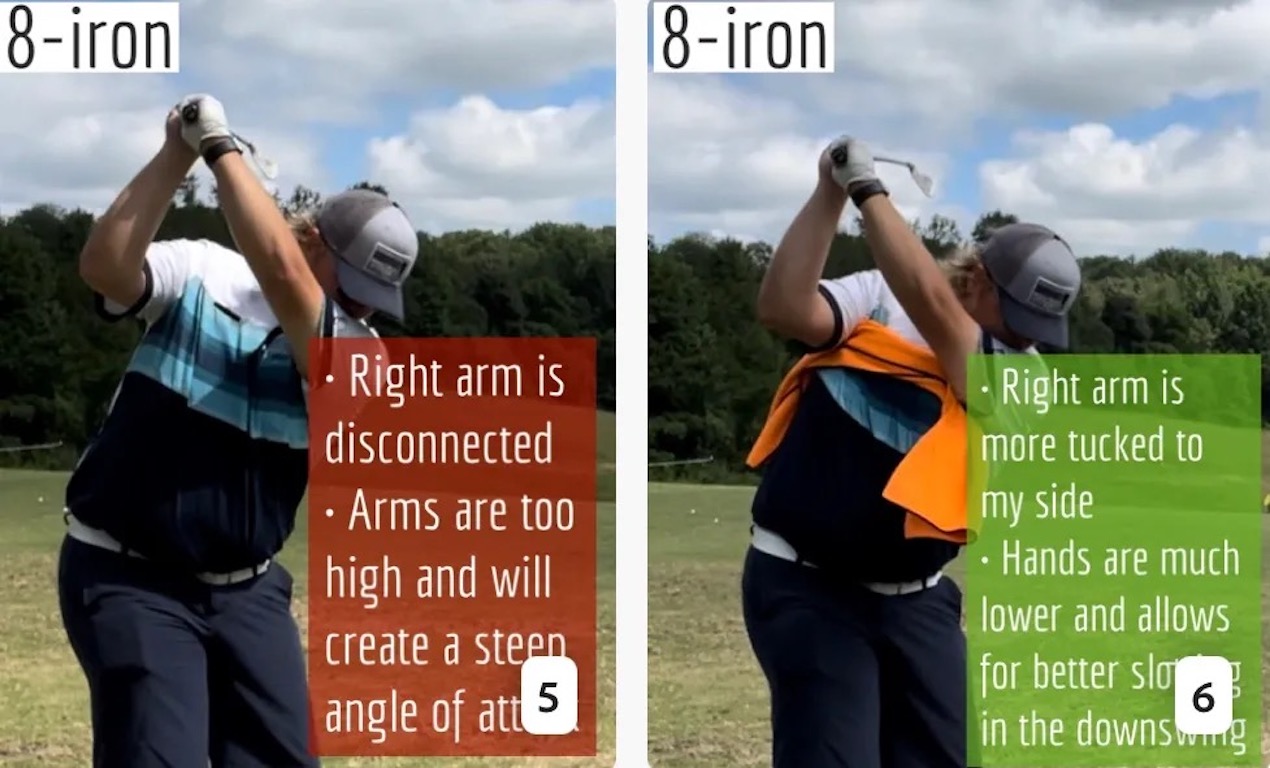
This is a classic drill that has been used for decades. However, the world of marketed training aids has grown so much during that time that this simple practice has been virtually forgotten. Because why teach people how to play golf using everyday items when you can create and sell a product that reinforces the same thing? Nevertheless, I am here to give you helpful advice without running to the nearest Edwin Watts or adding something to your Amazon cart.
For the “scoring clubs,” having a solid connection between the arms and body during the swing, especially through impact, is paramount to creating long-lasting consistency. And keeping that connection throughout the swing helps rotate the shoulders more to generate more power to help you hit it farther. So, how does this drill work, and what will your game benefit from it? Well, let’s get into it.
Setup
You can use this for basic chip shots up to complete swings. I use this with every club in my bag, up to a 9 or 8-iron. It’s natural to create incrementally more separation between the arms and body as you progress up the set. So doing this with a high iron or a wood is not recommended.
While you set up to hit a ball, simply tuck the towel underneath both armpits. The length of the towel will determine how tight it will be across your chest but don’t make it so loose that it gets in the way of your vision. After both sides are tucked, make some focused swings, keeping both arms firmly connected to the body during the backswing and follow through. (Note: It’s normal to lose connection on your lead arm during your finishing pose.) When you’re ready, put a ball in the way of those swings and get to work.
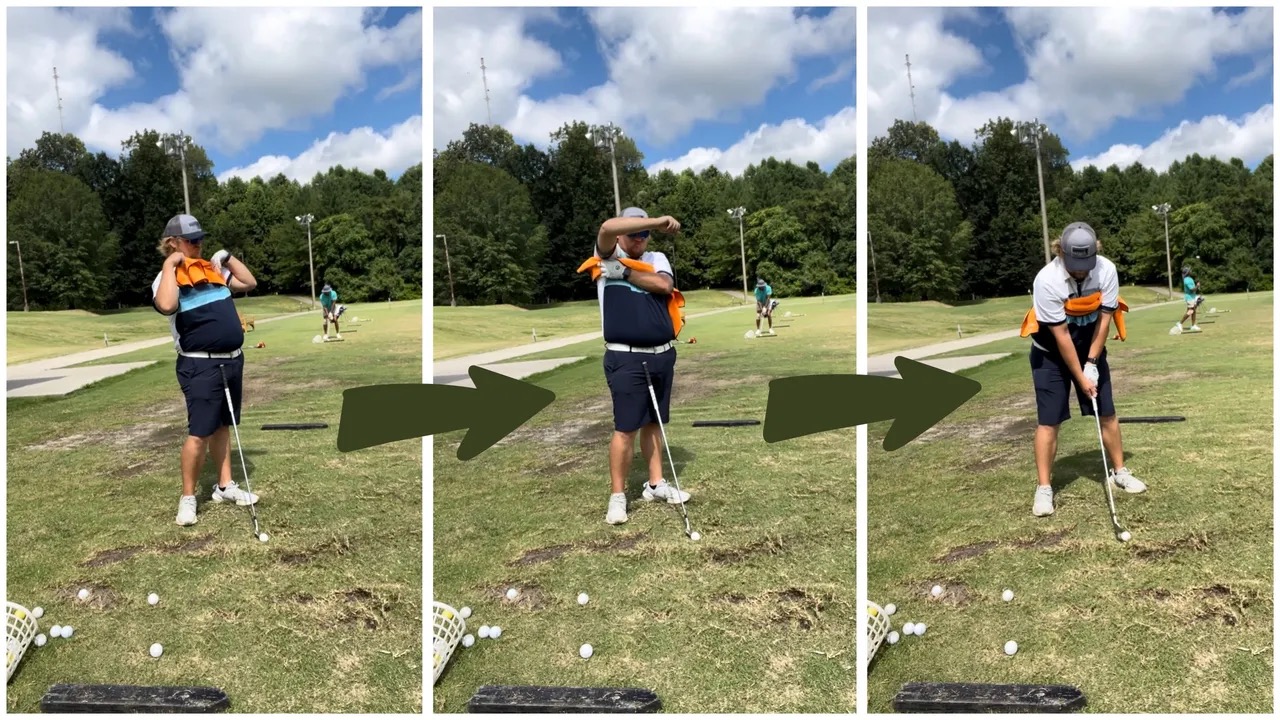
Get a Better Shoulder Turn
Many of us struggle to have proper shoulder rotation in our golf swing, especially during long layoffs. Making a swing that is all arms and no shoulders is a surefire way to have less control with wedges and less distance with full swings. Notice how I can get in a similar-looking position in both 60° wedge photos. However, one is weak and uncontrollable, while the other is strong and connected. One allows me to use my larger muscles to create my swing, and one doesn’t. The follow-through is another critical point where having a good connection, as well as solid shoulder rotation, is a must. This drill is great for those who tend to have a “chicken wing” form in their lead arm, which happens when it becomes separated from the body through impact.
In full swings, getting your shoulders to rotate in your golf swing is a great way to reinforce proper weight distribution. If your swing is all arms, it’s much harder to get your weight to naturally shift to the inside part of your trail foot in the backswing. Sure, you could make the mistake of “sliding” to get weight on your back foot, but that doesn’t fix the issue. You must turn into your trial leg to generate power. Additionally, look at the difference in separation between my hands and my head in the 8-iron examples. The green picture has more separation and has my hands lower. This will help me lessen my angle of attack and make it easier to hit the inside part of the golf ball, rather than the over-the-top move that the other picture produces.
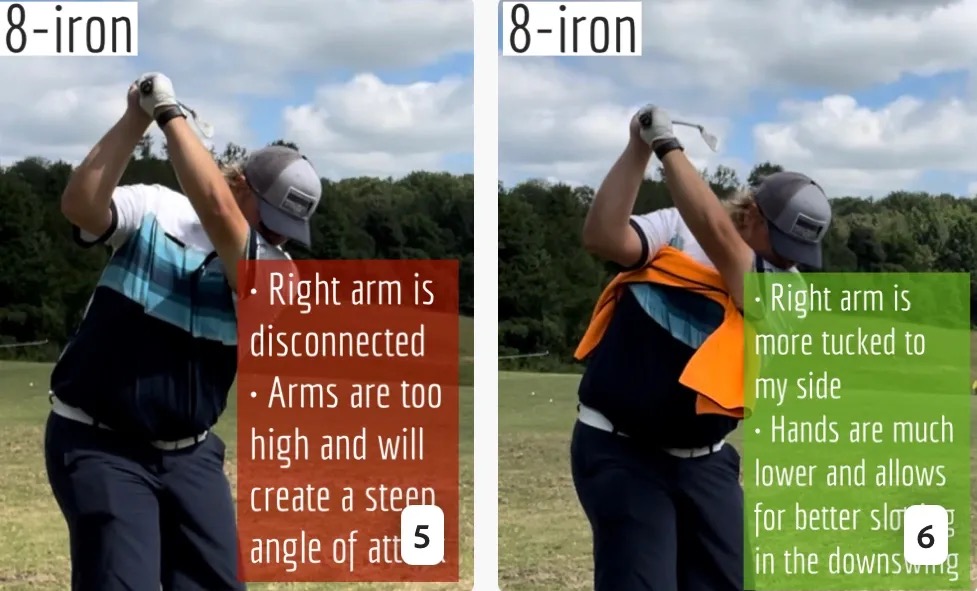
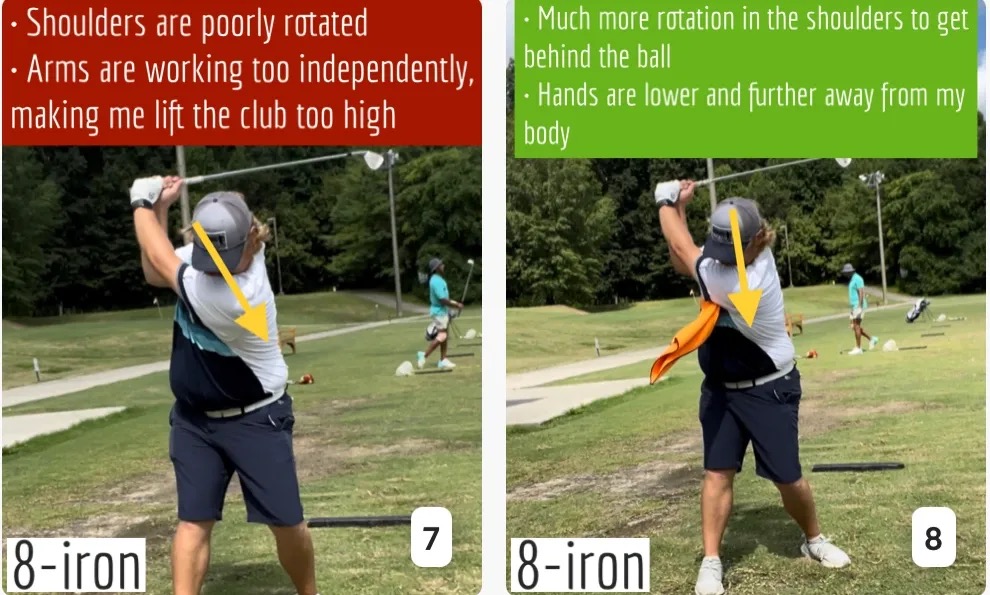
Stay Better Connected in the Backswing
When you don’t keep everything in your upper body working as one, getting to a good spot at the top of your swing is very hard to do. It would take impeccable timing along with great hand-eye coordination to hit quality shots with any sort of regularity if the arms are working separately from the body.
Notice in the red pictures of both my 60-degree wedge and 8-iron how high my hands are and the fact you can clearly see my shoulder through the gap in my arms. That has happened because the right arm, just above my elbow, has become totally disconnected from my body. That separation causes me to lift my hands as well as lose some of the extension in my left arm. This has been corrected in the green pictures by using this drill to reinforce that connection. It will also make you focus on keeping the lead arm close to your body as well. Because the moment either one loses that relationship, the towel falls.
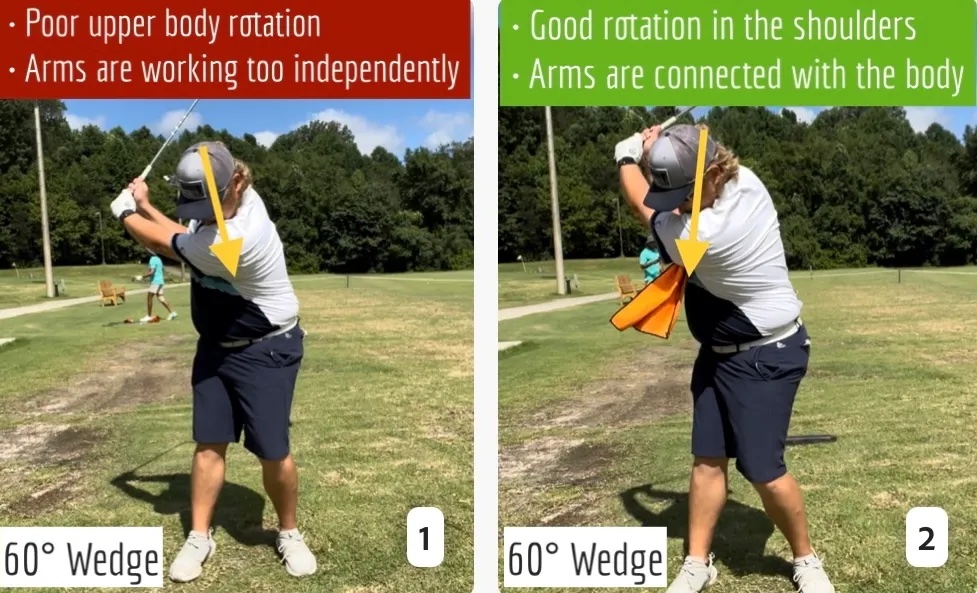
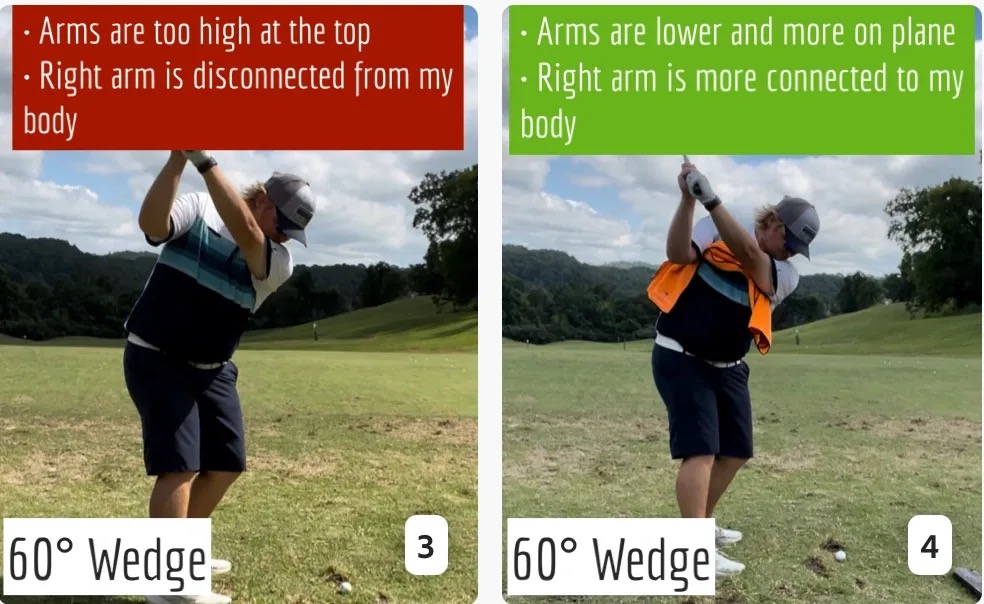
Conclusion
I have been diligent this year in finding a few drills that target some of the issues that plague my golf game; either by simply forgetting fundamental things or by coming to terms with the faults that have bitten me my whole career. I have found that having a few drills to fall back on to reinforce certain feelings helps me find my game a little easier, and the “towel drill” is most definitely one of them.
- LIKE12
- LEGIT2
- WOW2
- LOL0
- IDHT0
- FLOP2
- OB0
- SHANK8
-

 19th Hole2 weeks ago
19th Hole2 weeks agoDave Portnoy places monstrous outright bet for the 2024 Masters
-

 19th Hole2 weeks ago
19th Hole2 weeks agoTiger Woods arrives at 2024 Masters equipped with a putter that may surprise you
-

 19th Hole3 weeks ago
19th Hole3 weeks agoReport: Tiger Woods has ‘eliminated sex’ in preparation for the 2024 Masters
-

 19th Hole9 hours ago
19th Hole9 hours ago‘Absolutely crazy’ – Major champ lays into Patrick Cantlay over his decision on final hole of RBC Heritage
-

 19th Hole1 week ago
19th Hole1 week agoTwo star names reportedly blanked Jon Rahm all week at the Masters
-

 19th Hole7 days ago
19th Hole7 days agoReport: LIV Golf identifies latest star name they hope to sign to breakaway tour
-

 19th Hole1 week ago
19th Hole1 week agoNeal Shipley presser ends in awkward fashion after reporter claims Tiger handed him note on 8th fairway
-

 19th Hole6 days ago
19th Hole6 days agoBrandel Chamblee has ‘no doubt’ who started the McIlroy/LIV rumor and why









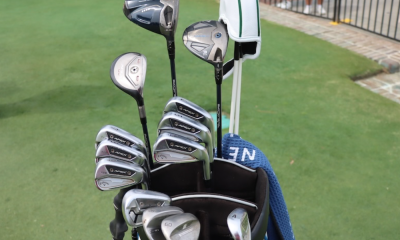

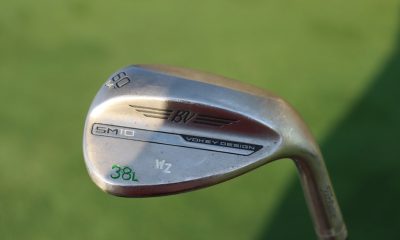





Mike
Mar 22, 2017 at 5:53 pm
What is a normal shoulder turn and hip turn number for a driver. For the pros? and what can or should an amateur strive for?
knoofah
Mar 18, 2017 at 2:57 pm
Completely disagree. The correct answers are:
DH
Superman
MARYANN, all day every day
Coke
Jarno
Mar 18, 2017 at 10:13 am
What is the measurable stats on shot dispersion before and after?
TexasSnowman
Mar 17, 2017 at 7:42 pm
Mary Ann
Dennis E Jones
Mar 17, 2017 at 9:30 am
“P.S. The correct answers to the start of the article are: Pitcher, Superman, Ginger and Coke.” You measured Ginger?
Rob Strano
Mar 17, 2017 at 7:48 pm
Ginger 35-22-36
Gotta have all the data Dennis!
Golf Scientist
Mar 17, 2017 at 8:56 am
While its true that using technology to measure what’s happening, and comparing amateur golfers to pro golfers (ideally a composite model, not a single golfer who has compensations and flaws) can be beneficial. However all of that is worthless if the person interpreting the data, and giving instruction provides bad information. Swing Like a Pro (ModelGolf), Drive Like the Pros (TMATT), and Titliest Performance Institute (TPI) all have excellent pro models, but I’ve seen all of them make interpretations about the data, and give advice that has bio-mechanical, logic, and/or physics flaws.
Robs suggestion to his student gave the student 10* more separation between the shoulders and hips at the top of the swing, but did really account for the reclaiming of distance, and did the suggestions that lead to the additional separation decrease accuracy and consistency? For people that buy into the “X-factor” distance theories its been said that its the stretch during transition not the separation at the top that account for increasing distance. (Its debatable if the body truly springs back like some people suggest. If you wind up your shoulders and thorax to its max, and then relax the tension and let the shoulders and thorax return to there natural position – not using any muscular force to turn them back – how fast and far did they move. You’ll probably note not very fast and not very far.
Now that Rob’s student is lifting his left foot stability and consistency (for the swing from that point on) are now compromised. Lifting the foot alters posture, brings in potentially lateral slide, and now the student needs to deal with replanting the foot on the way down. Both in consistent replacement of the foot in relation to where on the ground, as well as when and how to do it. The student now has more compensation to make, and will likely be less consistent.
Maybe the separation issue could have been solved by looking at how the student rotated (both conceptually and physically in the backswing (ex : muscles pushing vs pulling, right side vs left side, diagonally vs horizontally).
The 10* additional rotation on the backswing may not have had anything to do with the added distance. Maybe the whooshing drill (and possibly better order or synchronization of body parts on the downswing accounted for the increased distance.
Scientific and mathematical data about the golf swing is wonderful, but it needs to be interpreted correctly.